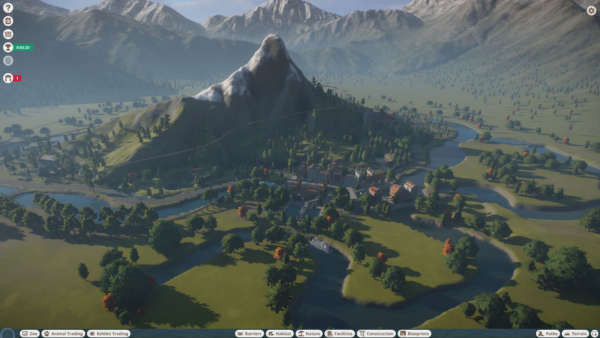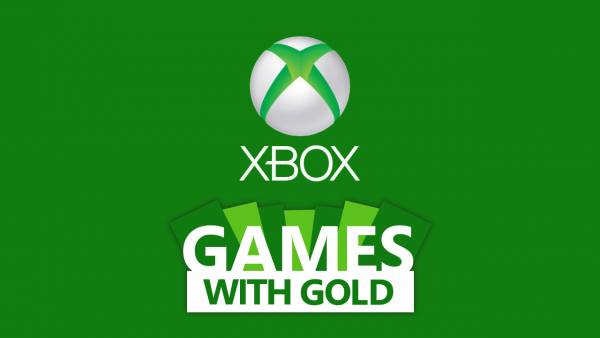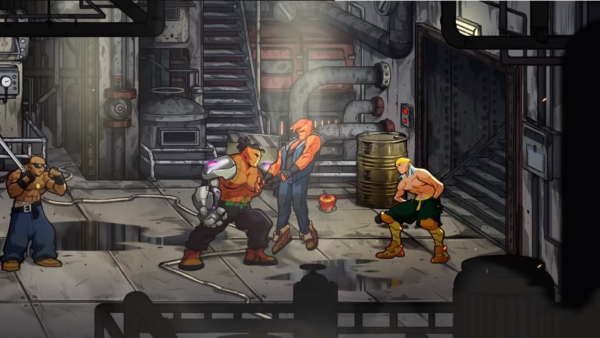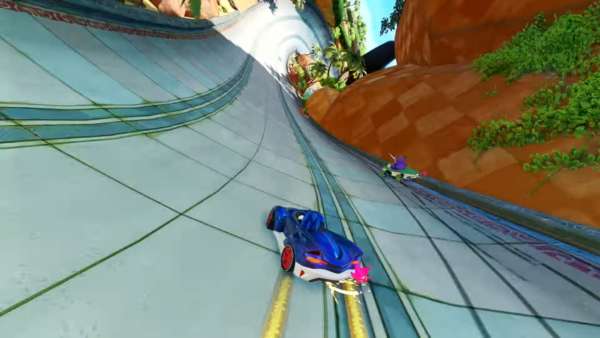If you happened to be standing on the gaming train tracks a few weeks ago, you may have found yourself being crushed to death by the hype train as the 14:03 service to Titanfall steamed through town. Rather than beast out a review in a few days, I thought it would be better to really get into the game and look at its long term appeal. That’s my excuse and I’m sticking to it, it has absolutely nothing to do with the fact I’ve been playing it pretty much non-stop for 3 weeks…nothing at all.
For those of you who have been in lower earth orbit recently (hey Mr Hadfield, thanks for reading), Titanfall is a sci-fi, 6 vs 6, team-based multiplayer first-person shooter from Respawn Entertainment, a new studio formed by Vince Zampella and Jason West, formerly of Infinity Ward.
So to address the issue right off the bat. No, it isn’t the second coming of Jesus. It doesn’t cure Salmonella poisoning and it won’t tell you the meaning of life. What it will do is entertain and exhilarate you. Is it just Call of Duty with mechs and free-running? Kind of, but that’s hardly a fair criticism nor should it imply that Titanfall isn’t vastly different from Call of Duty. If you added mechs and free-running to FIFA, the objective would still be to get the ball in the net, but the gameplay processes involved in doing so would be vastly different.
Call of Duty may have influenced the shooting mechanics to a large degree, but the movement style will cater more to Halo players than the typical COD crowd. You don’t need to flank somebody by running around to the other side of the building, just jump over the wall, land behind him and snap his neck.

It’s hard to show off wall-running in first person screenshots, but trust me, it looks cool in motion.
The freedom offered by Titanfall’s movement style, which allows you to not only run along walls, but also chain wall runs together via the use of your jetpack, means that you’ll see the maps in a new light. The speed with which you can navigate the maps means that you’ll never be more than a few seconds away from your next fight. Whilst we’re talking about the fights, remember Halo’s infamous ‘30 seconds of fun’ mantra? Well Titanfall aims for 5 seconds of ‘Oh my god that was awesome, I’m awesome’ instead. Each encounter is a brief but epic battle and when the dust settles, you’re already wall-running off to find your next 5 seconds.
Sweet movement mechanics are no good without somewhere to move, and Titanfall doesn’t disappoint with its environments. Featuring 15 maps in total (with more coming later as paid DLC), Titanfall is one of those rare games where none of the multiplayer maps come off as ‘duds’. There is an immense amount of variety in both the artistic style and the gameplay they offer. Boneyard takes place at an abandoned IMC facility in the desert, so expect wide open spaces littered with disused bunkers, as well as the rather striking skeleton of a Leviathan in the middle of the arena. Move to Angel City and things get a lot cosier, with claustrophobic streets for titans to wage war in whilst pilots run and gun through buildings and on rooftops.
What impresses me the most about Titanfall’s maps though, is how well they cater to the movement mechanics. Buildings, billboards and downed spaceships all fit together beautifully to provide you with the ultimate parkour playground. Even the wide open maps like Boneyard have ziplines and rock formations to ensure that you’ll never be footslogging it for long.
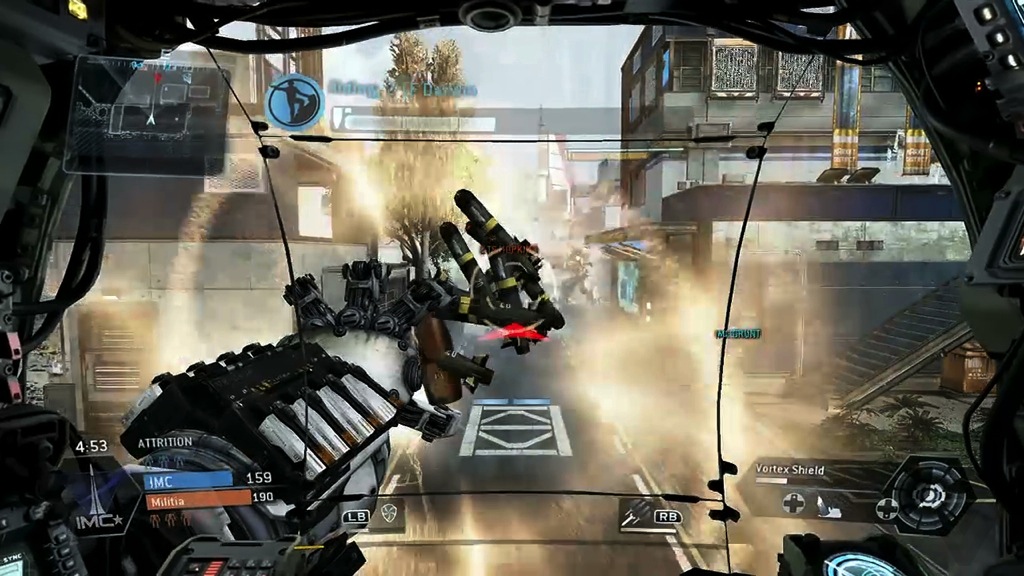
Titans can be given a vortex shield, which stops bullets and rockets dead in their tracks, before firing them back at the enemy.
One of Titanfall’s unique features is the addition of Burn Cards, which have replaced kill streaks…sort of. At the start of the game you can equip three burn cards which can be activated at the start of a life. These range from better versions of guns and abilities to free titans and map hacks. They add a lot of spice to the gameplay but very rarely shift the balance of a game too much. An opponent’s burn card might cost you a life, but it shouldn’t cost you the game. If your team can’t deal with a lone titan at the start of the round, you were probably in trouble anyway.
Unlike Call of Duty, which features a bountiful platter of assault rifles, submachine guns and the like, Titanfall keeps its arsenal lean. There aren’t 18 different shotguns, there is one. This diet NRA approach to weaponry might seem like a step-backwards, but it’s certainly a damn sight easier to balance a smaller repertoire of weapons, and this shows. None of the guns, not even the infamous Smart Pistol, are overpowered; everything just fits into its role and does its job.
It’s a similar story with the titans, of which you’ll find three. The Atlas is the all-rounder, the Stryder is fast as you like but made of butter, whilst the Ogre is an absolute tank with the pace and manoeuvrability of your average house. Each Titan can be customised to fit your playstyle with upgrades like electric smoke to remove enemy pilots from your hull, or even a ‘small’ nuclear bomb which explodes as you eject from your titan. Again the titans are all extremely well-balanced and suited to their roles. If you’re in an Ogre and you run into a Stryder out in the open, he’ll run rings around you; drag him in between the buildings and you’ll soon be pulling his arms off and beating him to death with them.
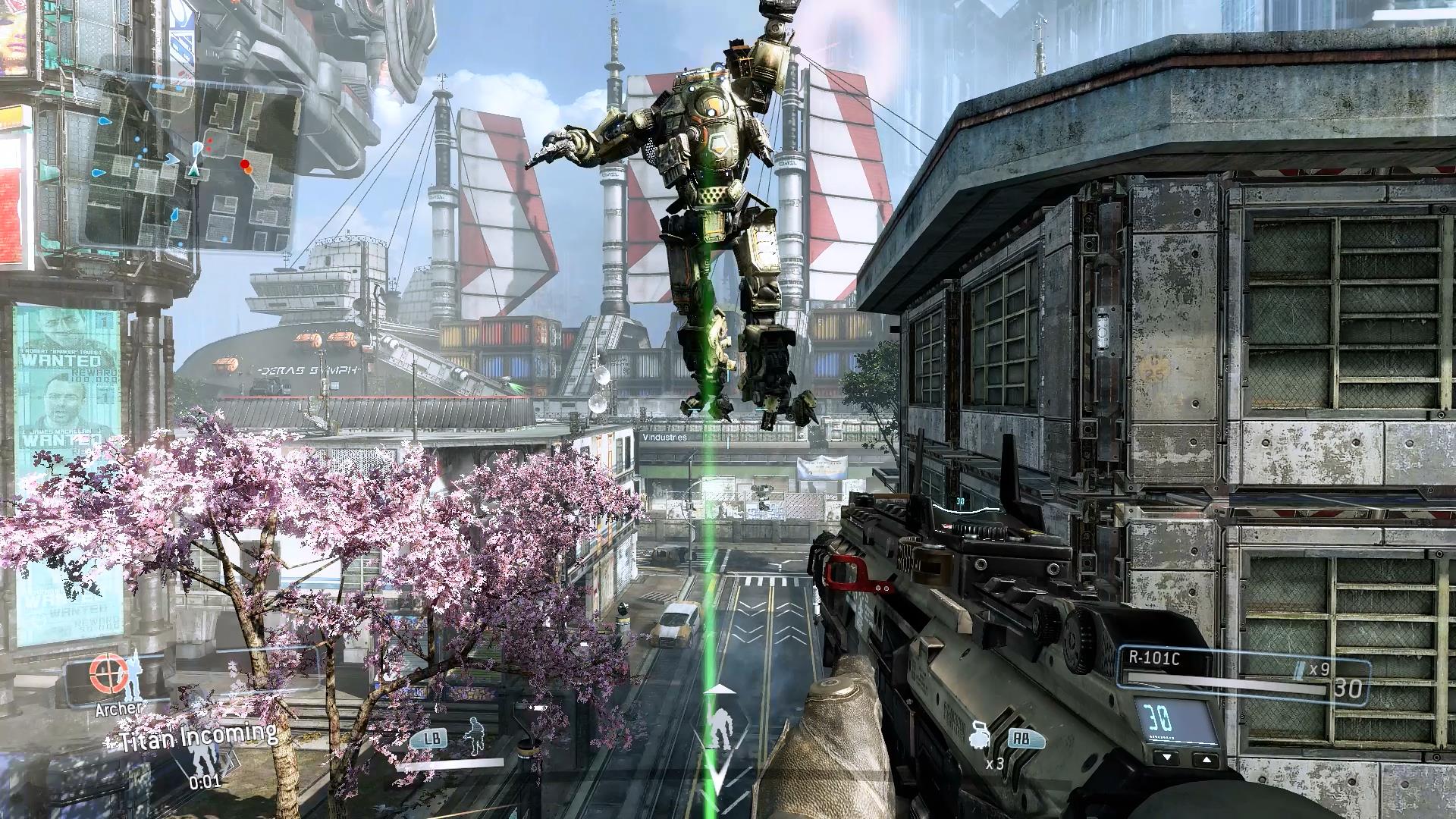
Your titan comes in from space, which is very cool. Even cooler is that fact you can drop it on enemy titans, killing them instantly, a manoeuvre known as a ‘bonk’.
Titan gameplay is very reminiscent of Hawken, the free-to-play mech shooter on the PC, which is pretty apt considering I describe Hawken as Call of Duty in mechs. Unlike Hawken, you need to earn your titan, which you do by scoring kills on pilots and grunts, both of which take time off the countdown to titanfall. Once your titan is in, the combat is a lot more conventional, taking place in between buildings rather than on top of them. Whilst you’re pretty durable and very deadly to a pilot on the ground, you’re aren’t invincible. Enemy pilots have anti-titan weapons and they can even board your titan, destroying you from within your own shield. In addition to Hawken, the mech-on-mech combat has a very Pacific Rim sort of feel to it, with each shot and punch to an enemy titan really feeling weighty and destructive.
Sadly, Titanfall continues this small but perfectly formed mantra in the game modes. Shipping with a paltry 5 gametypes, Titanfall is certainly lacking in variety on this front. That’s not to say anything against what is here though, as each game mode works wonderfully, each asking you to adapt to a new playstyle. Attrition is your standard team deathmatch, with kills against pilots, bots and titans all helping your team to victory. Pilot Hunter caters to the purists out there by ensuring that only pilot kills count towards to score. Capture the Flag and Hardpoint Domination provide the objective based gameplay, both offering you a chance to play attack or defence. Finally Last titan Standing fills out the roster, with both teams starting in a titan and the last team with one left alive being declared the winner.
Whilst we’re talking about what is missing from Titanfall, I should probably touch upon the contentious issue of the game’s campaign. Titanfall’s campaign allows you to play a series of Attrition and Hardpoint matches as both the IMC and the Militia. At the start of the mission you’ll get a small in-game cutscene where some characters chat about why you’re fighting in that particular place today. It is not a replacement for the single player campaign by any means, and if you go into it looking for that you will be sorely disappointed. But as a way to add a little context to the multiplayer matches, it’s quite a novel idea.
Like most novel ideas though, there is usually a good reason it hasn’t been done before. A single player game can wrestle control of your character away from you to deliver exposition. Titanfall’s multiplayer only nature means that when key plot related elements are being delivered over the radio, chances are good you’ll be too busy blowing someone’s face off to pay attention. The plot itself is pretty simple too; it basically boils down to South Africans and robots are evil, and everyone else is good so they have a big fight for reasons. We’re assured the IMC are evil but beyond the fact that they are a corporation so they must be. Personally I prefer playing as the IMC because then I get that epic South African guy, Blisk, as my support voice.
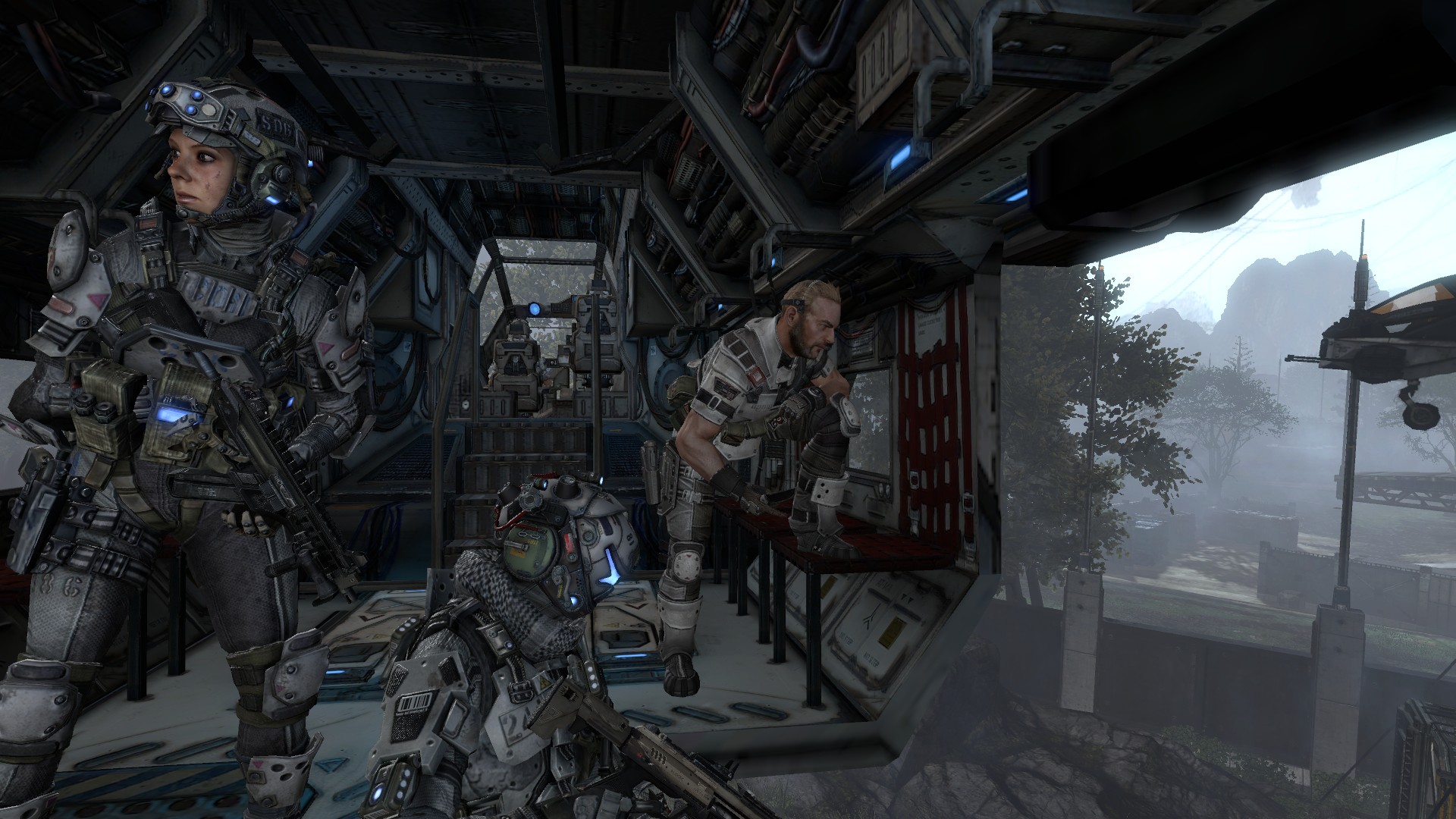
“E’s gowing to ‘old a grudge, ey”. Blisk’s accent is amazing and enough reason to side with the IMC over the Militia.
With that said, a lot of critics of Titanfall have said it doesn’t provide good value for money because it lacks a single player component, an argument I just don’t support. The value of a game should be weighed on the amount of time and enjoyment you get out of it, not on whether it fills in the ‘every game must have this’ checkboxes. If you’re normally a campaign and trade-in kind of player then Titanfall isn’t for you, but if you’re looking for a slick, fast-paced and fresh feeling multiplayer shooter then look no further.
Another issue worth mentioning is that of the frame rate. I played Titanfall on the Xbox One and for the most part the frame rate was solid, however there were several occasions when the frame rate went to hell, usually when multiple titans were fighting and setting off nukes all at once. It’s a relatively rare issue but an annoying one none the less. A slightly less flashy nuke effect might have made for a more stable experience.
Titanfall may not be the second coming of multiplayer shooters, but it’s a damn fine game and it deserves recognition for shaking up a genre that had become extremely predictable. It’s a little light on game modes, but what is there is beautifully crafted and extremely entertaining. Titanfall is a true water cooler game, and with the addition of the Xbox One’s in-built game DVR, ‘Xbox record that’ might just be your new favourite phrase. Unless you’re on the PC or 360 of course.
